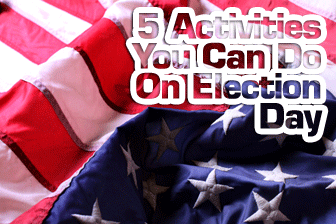Itís a Secret: 5 Activities You Can Do On Election Day


However, it is important that they understand the workings of the government where they live. In the United States, there are three branches of the government that keep each other in check. These lessons are geared toward those at an intermediate or higher level as they require some more advanced vocabulary and concepts in English.

To start, you will need to explain that there are three branches of government in the United States. A good way to show this is to draw a tree, write government on the trunk, then write executive, legislative and judicial on each of the branches. Also, have a picture of the President for executive, Congress for legislative and the Supreme Court for judicial. This will give students some idea of what you are saying before you even explain it. Tell them that the founding fathers of the US did not want anyone in the government to have too much power, so they created the three branches, each with its own limitations. In this way no one has all the power in decision making. All of these officials meet in Washington, D.C, the nation’s capital.
The executive branch consists of the president, the vice president and cabinet members (heads of various departments). The president is elected by the people and may serve up to two four year terms. The people of the United States vote for the president and vice president. The president chooses his cabinet members. You may want to explain about how the word “cabinet” relates to a kitchen cabinet, keeping everything in one place. Make sure the students know who our president and vice president are. You should let them know the names of the positions in the cabinet. They should know that the president is the leader of the country and commands the military. The vice president is the President of the Senate and becomes president of the US if the president can no longer do his job. The cabinet members advise the president on important matters. The president approves bills that were approved by the House and the Senate so they become laws. He can also veto a bill, but if 2/3 of Congress votes against him they can override that veto and it can still become a law. However, the president cannot actually write bills himself. He also leads the military. He can authorize the use of troops without declaring war, but must get the approval of Congress to declare war.
The legislative branch writes the laws. It consists of two sections: the House of Representatives and the Senate. Together we call them Congress. The purpose of the two houses is to be fair to the people of the United States. In the Senate, there are two elected officials from each state. The number of representatives in the House of Representatives (also elected officials) from each state depends on the population of that state. The more people the state has, the more Senators they have. Congress can write bills, which when approved, can become laws. Each Congress lasts for two years. When the two years are over, new members of Congress are elected.
The judicial branch is the part of the government that makes sure the laws are carried out fairly. In the United States, the judicial branch consists of the Supreme Court Justices, of which there are nine. These justices are nominated by the president, but must be approved by the Senate. One of these justices is the Chief Justice. The Supreme Court is the highest court of the United States. Justices have their jobs for life, unless they resign, retire, or are impeached by the House and convicted by the Senate. Of about 7,500 cases that are sent to the Supreme Court every year, only about 80-100 cases are heard there. Once the Supreme Court makes a decision, only another Supreme Court decision or an amendment to the Constitution can overrule it.
After your students learn all about the three branches of United States government, here is a fun activity to do to tie it all together. Give each pair of students an outline of a tree that has three branches. Have them label the trunk as government, and one branch each for executive, legislative and judicial. Next, give them pictures of the officials in each branch, and facts about each branch. Have them match them to the right spot. When they are done, have students take turns reading the facts aloud. If they are willing, students can come up to the front of the room and share their project.
Finally, for the more advanced learners, it would be fun to have a debate about which branch is the most important. Of course, they are all important in running the US government, but debate is a fun way for more advanced students to utilize their skills. Divide the class into three teams and assign each team a branch. Have them come up with ways that branch can help the US. Have each group choose a speaker and let the three students take turns arguing their points. There may be a rebuttal if you choose. Finally, have the students vote (secret ballot, of course!) for the team who they thought presented the best argument, and announce the winner. Competition often brings out the best in people in general, and so it probably will in your students. You will be surprised at how confident they will become in using English when bragging rights are at stake!
It will help them in everyday conversation and possibly help them to assist their children with their homework, if that is the case. Use these activities to make sure your students know all about it.